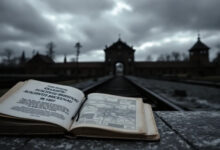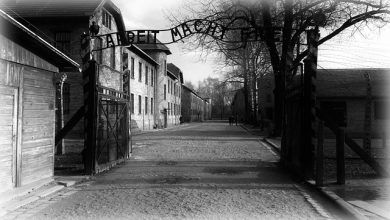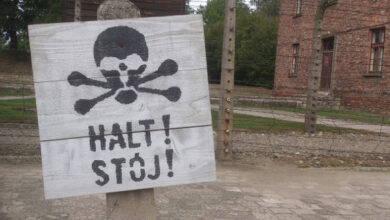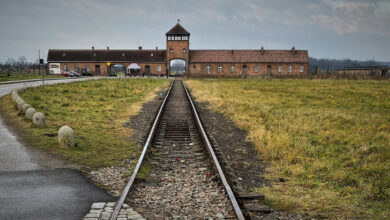Visit Auschwitz Birkenau Camp – Book Online
Book Online Your Visit to Auschwitz Birkenau with KrakowTOP
When planning your visit to the Auschwitz-Birkenau Camp, a site of immense historical significance, it’s advisable to book your entry in advance due to the high demand for tours.
The online booking system, available at visit.auschwitz.org, enables you to secure your place. It is the only platform where the Museum guarantees the validity of tickets.
On arrival, you should aim to be at least 30 minutes early before the start time of your tour. As you’ll be walking through the sombre reminders of history, it’s essential to familiarise yourself with the visiting rules and the Museum’s opening hours in preparation for your visit.

Understandably, a visit to Auschwitz-Birkenau is a profound and educational experience. One of the options available to you is participating in guided tours, which provide a comprehensive narrative live from an educator and the integration of multimedia materials.
This experience illuminates the historical context and the impact the camp has had on our understanding of the Holocaust. Please note that visits are not recommended for children under the age of 14 due to the sensitive nature of content displayed at the Museum.
Lastly, bearing in mind the weight of history that you will encounter, visiting Auschwitz-Birkenau is more than a simple tour; it’s an educational journey. It’s crucial to consider preparing for the visit with an online lesson offered by the Museum.
This lesson details the Nazi ideology, the political climate of the era, and the unimaginable realities that unfolded within the camp.
These offerings are designed to provide a foundational understanding before you set foot on the grounds where history’s darkest chapters unfolded.
Planning Your Visit to Auschwitz Birkenau Camp

When arranging a trip to the Auschwitz-Birkenau Camps, it’s crucial to consider several key factors. These include booking your Auschwitz tour online in advance, identifying the best time of year for your visit, understanding the entry card and fee requirements, and being aware of the opening hours.
Booking Auschwitz Birkenau Camp Tour Online
To ensure your place, you should book your visit online at visit.auschwitz.org well in advance. The demand for tours is high throughout the year, so early booking can help you avoid disappointment.
This can be done easily through the official website, where you’ll find a range of tour options to suit your schedule.
Best Time to Visit
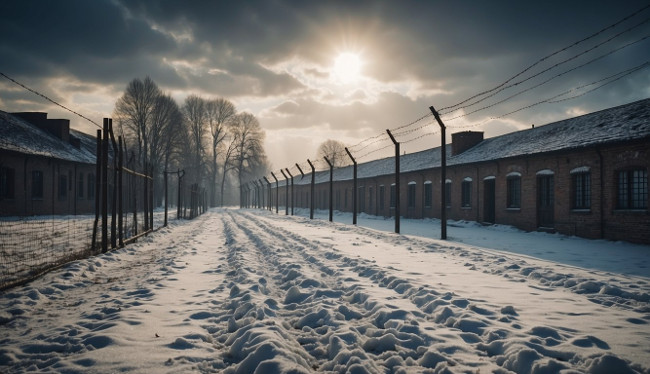
The best time to visit Auschwitz-Birkenau varies.
The months of April, September, October, and November often provide a balance of tolerable weather and fewer visitors.
The winter months, especially January and February, can be very cold, while March and December typically see a significant increase in visitor numbers due to school holidays and commemorations.

Auschwitz Entry Cards and Fees
Entry cards to Auschwitz-Birkenau are mandatory for all visitors. Fees may apply for guided tours, and detailed information on this can be found on the official website, visit.auschwitz.org.
Certain tours may include additional features, such as educational sessions or extended visits, which could affect the overall cost.
Opening Hours
The Auschwitz-Birkenau Museum has varied opening hours throughout the year, which are regularly updated on their website.
It’s important to check these before your visit and arrive at least 30 minutes prior to the start of your tour.
This will provide you with ample time to prepare and enter the museum. Please remember that larger luggage items should be left in vehicles in the parking area.
Getting to Auschwitz

When planning your visit to the Auschwitz-Birkenau Camp, it’s crucial to consider the available transport options to ensure a smooth journey. Below you’ll find detailed information about transportation methods as well as parking facilities upon your arrival.

Available Transport Options to Auschwitz
By Bus:
Regular bus services run to Auschwitz from a variety of locations throughout Poland.
Buses frequently depart from Kraków, with the journey taking approximately 1.5 to 2 hours.
It’s advisable to check the current timetable and plan your trip in advance, especially during peak tourist seasons. Read also Auschwitz Tours from Krakow
By Car:
If you’re driving to Auschwitz, take into account that the A4 motorway is the main route that connects Kraków to the town of Oświęcim, where Auschwitz is located.
The drive should last around an hour, depending on traffic conditions. Read also Krakow Auschwitz Distance

By Train:
Train services are available to Oświęcim from major cities like Kraków, but the frequency may be less than that of buses.
Keep in mind that the train station is a short distance from the museum, so a connecting bus or taxi will be necessary from there.
Tour Services:
Many visitors opt for an organised tour that includes transport to and from the site.
These tours can be booked online and often offer a pick-up and drop-off service from your hotel.
Parking Facilities
At Auschwitz I:
Upon reaching the museum, you’ll find a paid car park on-site. It’s equipped to accommodate a substantial number of vehicles including buses.
Charges apply, and it’s a good idea to arrive early during peak periods to secure a spot.
At Birkenau:
The car park here is larger and can also accommodate coaches. Just like Auschwitz I, it is a paid parking area, so make sure you have local currency to pay for your parking ticket.
The museum provides detailed guidance on how to navigate to both sites, and it’s recommended to familiarise yourself with this information before setting off.
Guided Tours to Auschwitz Birkenau Camp

Visiting the Auschwitz-Birkenau Camp is a poignant experience where guided tours are conducted to offer in-depth insights into the site’s tragic history. These tours are available for groups, individual visitors, and educational purposes, ensuring a comprehensive understanding for all attendees.
Group Visits
If you’re planning to visit with a group, it is advisable to book a guided tour in advance, as this ensures entry and a shared experience led by a knowledgeable guide.
Tour duration typically spans several hours, covering both Auschwitz I and Birkenau. Languages offered for Auschwitz Birkenau guided tours usually include English, Polish, Spanish, French, and Italian.
- Advance booking: Essential for groups
- Tour languages: Multiple options available
Individual Visits
For individual visitors, you have the flexibility to explore the Memorial independently or join an organised tour.
An individual online guided tour is also available, which lasts about two hours and is divided into two parts, encompassing Auschwitz I and Birkenau, complete with live narration from an educator. Read also Auschwitz Tickets Without Guide
- Booking: Online at visit.auschwitz.org
- Tour option: Online individual visit
- Duration: ~2 hours with guide narration
Educational Tours
Educational tours are specifically tailored for students and are conducted by guide-educators who specialise in historical and pedagogical aspects of the site.
These study tours are not only informative but also appropriate for the educational level and age of the participants, while abiding by the rules for visiting.
- Educators: Specialised guide-educators
- Suitability: Tailored to educational level and age
- Reservations: Required via the official website
Note: Prior to your visit, make sure to check the official website for any updates regarding rules or availability due to conservation work or other reasons.
What to expect on your visit to Auschwitz

When you visit Auschwitz-Birkenau, you’re stepping onto a site of immense historical importance, a memorial to the victims, and a museum preserving the truth of tragic events.
You will encounter the chilling history of the Holocaust and Nazi crimes, displayed across the grounds, buildings, and exhibitions at both Auschwitz I and Auschwitz II-Birkenau.
Historical Significance
Auschwitz I, originally a concentration camp, became a central site in the Holocaust where countless Jews, Roma, and other prisoners were exterminated.
Auschwitz II-Birkenau, the vast extension, served primarily as an extermination camp with gas chambers and crematoria. Your visit will confront the stark realities of Nazi crimes and the magnitude of the tragedy that unfolded here.
Memorial Sites

The grounds of both camps have been preserved as a memorial to those who lost their lives. At Auschwitz I, you can view the infamous “Arbeit Macht Frei” gate as you enter.
At Birkenau, the remnants of the gas chambers and crematoria stand as harrowing reminders of the lives taken there. The memorial sites provide a space for reflection and remembrance.
Museum Exhibitions
The museum exhibitions present a detailed history of the camp’s operation and daily life of the prisoners through a collection of personal items, photographs, and documents.

Exhibitions are carefully curated to educate visitors about the scope and scale of the Holocaust, the personal stories of the victims, and the living conditions within the camps.
Expect to see a diverse range of artefacts that give voice to the silenced history.

Rules and Regulations at Auschwitz
When planning your visit to the Auschwitz-Birkenau Memorial, be aware of the specific rules and guidelines in place. These rules maintain the solemnity and respect due at this historic site.

Visitor Conduct
You are expected to behave with the utmost respect at all times during your visit. The Memorial is a place of remembrance for the victims of the Holocaust, and as such, a solemn attitude should be upheld.
You must adhere to the following rules of visiting:
Start Planning Your Krakow Trip Now!
- Unsure where to stay in Krakow? Discover top-rated Old Town and Kazimierz hotels with Booking.com. Reserve now, pay later, and enjoy free cancellations.
- Book your airport transfer now and enjoy a hassle-free ride directly to your hotel. Driver will meet you at John Paul II International Airport Kraków–Balice.
- Take a Sobering Tour of Auschwitz. Arrange a visit to the Auschwitz-Birkenau Memorial and Museum to pay tribute and learn about this significant historical site.
⏰ Due to high demand, it’s strongly recommended to book your tickets, tour to Auschwitz and accomodation well in advance to secure your preferred dates and times! 🔖
- Explore the Fascinating Wieliczka Salt Mine! Book your guided tour today and discover this UNESCO World Heritage site just outside Krakow. These tours are popular year-round, so book early to avoid disappointment and ensure your spot.
- Looking for ideas? Check out our KrakowTOP.org recommended itineraries, including the famous Christmas Market, holiday events, and must-see Krakow attractions like Wawel Castle, Oskar Schindler’s Factory and St. Mary’s Basilica.
- Security Checks: Upon arrival, security staff will ask you to undergo a security check. It is essential to cooperate fully with the security staff to ensure a smooth and respectful visit for everyone.
- Backpacks and Handbags: Larger bags are not permitted on the grounds. If your backpack or handbag exceeds the size allowed, which is 30x20x10 cm, you will need to store it in the designated area before entering.
Read also:
- Airports Near Auschwitz
- Auschwitz and Wieliczka Tour from Krakow
- Auschwitz Dress Code
- Auschwitz Krakow Weather
- Auschwitz Tour Price
- Auschwitz: What to Expect During Your Visit
- Can You Visit Auschwitz from Krakow?
- How to Prepare for Auschwitz Tour
- Krakow Airport to Auschwitz
- What Do I Need to Know Before Going to Auschwitz?
- What not to do at Auschwitz
Prohibited Items
There are specific items that you are prohibited from bringing into the Memorial. Be sure to review and comply with these restrictions to avoid any issues during your visit:
- Photography Equipment: Tripods, stands, and other professional photographic equipment are not allowed without prior permission.
- Food and Drink: Consuming food and drink on the museum grounds is not permitted.
- Smoking: Smoking is strictly prohibited throughout the site.
Following these regulations helps maintain the respect and integrity of the Memorial, offering a profound experience for all who come to remember and learn about the past.



